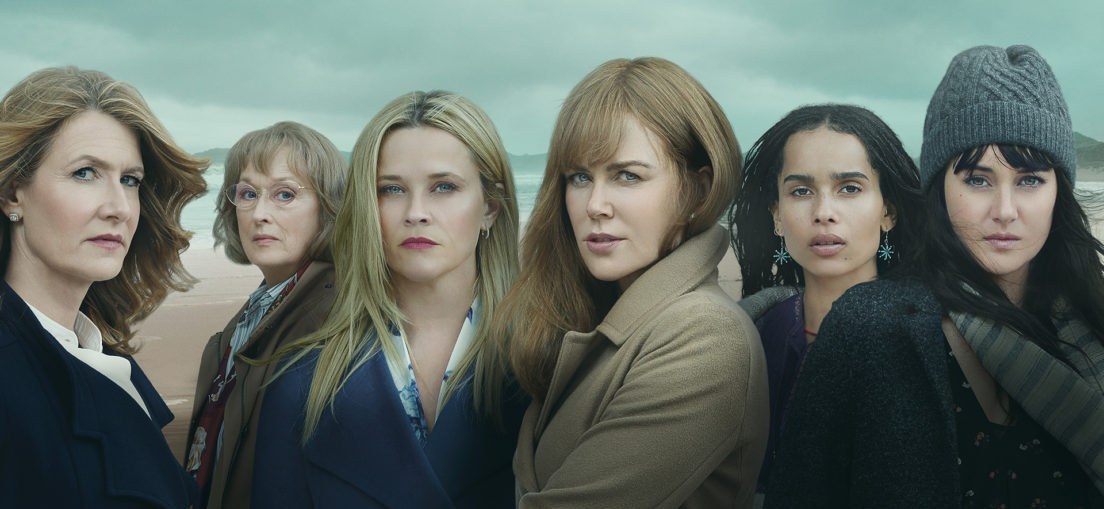
Article by: Josh Bradley
In May, HBO’s five-part miniseries Chernobyl premiered to rave reviews, inspired some of the dumbest Instagrams you will ever see, and for a moment became the highest-rated TV show on IMDb, topping juggernauts like Breaking Bad, Game of Thrones, and The Wire (it has since fallen to #4, behind two versions of Planet Earth and Band of Brothers). The show’s creator, Craig Mazin, who wrote all five episodes and also served as executive producer, has been a working screenwriter for over twenty years but up until Chernobyl had only feature film credits to his name. On The Ringer’s Big Picture podcast, Mazin had this to say about the jump to TV:
“My interest in relaying this in a narrative on screen really emerged in 2014, and it was just around the time that formats were starting to become flexible. Prior to that, the miniseries was some junky network event where they do a novel or something. Then this beautiful format that the UK was already very heavily invested in, which was just ‘make six episodes, it sounds great’, it started to come over here [to the US].”
Mazin went on to say that writing the miniseries has already radically changed his career, and that he intends to stay in this format and make more television shows like this from now on instead of focusing on feature films.
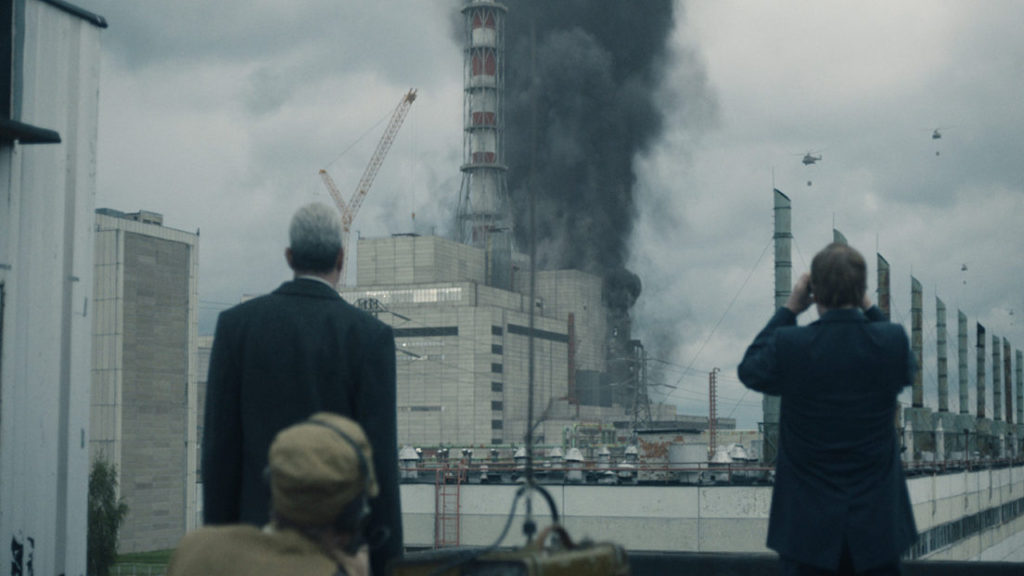
For all the ado about Chernobyl being Mazin’s first foray into TV and temporarily taking over the TV crown (at least as far as IMDb users are concerned, whatever that means), it’s interesting how much the show falls into that gray area, into the middle of the flexibility of the formats that Mazin alluded to. With it’s close-ended narrative, cinematic aesthetic, and bingeable five-hour runtime, it’s the latest and one of the clearest examples of the blurring line between movies and TV.
But I would even take it a step further: Chernobyl is exactly the kind of the show that is not only blurring the line, but eliminating it.
Ok, before you roll your eyes, to be clear: most media we consume still falls into one category or the other- I’m not trying to argue that The Good Place and Good Time are the same medium. But the distinctions that used to be clear have grown tenuous over the past few years, to the point that some now seem completely arbitrary.
Ten years ago – heck, even five years ago – you could define movies and TV in distinct terms. You could confidently say movies were a story told with picture and sound, running somewhere between 90 and 150(ish) minutes in length, almost always telling a close-ended narrative, and originally distributed in movie theaters before landing on DVD, HBO, Netflix, iTunes, etc, some months later. On the other end, you could confidently say a TV show was a story told with picture and sound, delivered episodically in 22- to 60(ish)-minute chunks over some number of discrete chunks (each usually close-ended to some extent but open-ended enough to continue the story for the next episode), produced for a considerably smaller budget than a given movie, and airing on a television channel or, more recently, a website.
Put simply, movies and TV have always been divided by their length, by the type of story being told, by their respective budgets and production schedules, and by how we watch them. Never the twain shall meet.
In 2019, many, if not most, of these distinctions are now laughable. In April, an 82-minute episode of Game of Thrones aired the same weekend that Avengers: Endgame opened in theaters. The former had a production schedule twice as long as many feature films, and the latter was the conclusion of 22 interconnected movies released over the course of 11 years, a “series finale” of sorts for this phase of the film franchise. Just the term “film franchise” is telling about the serialized, episodic state of studio movies.
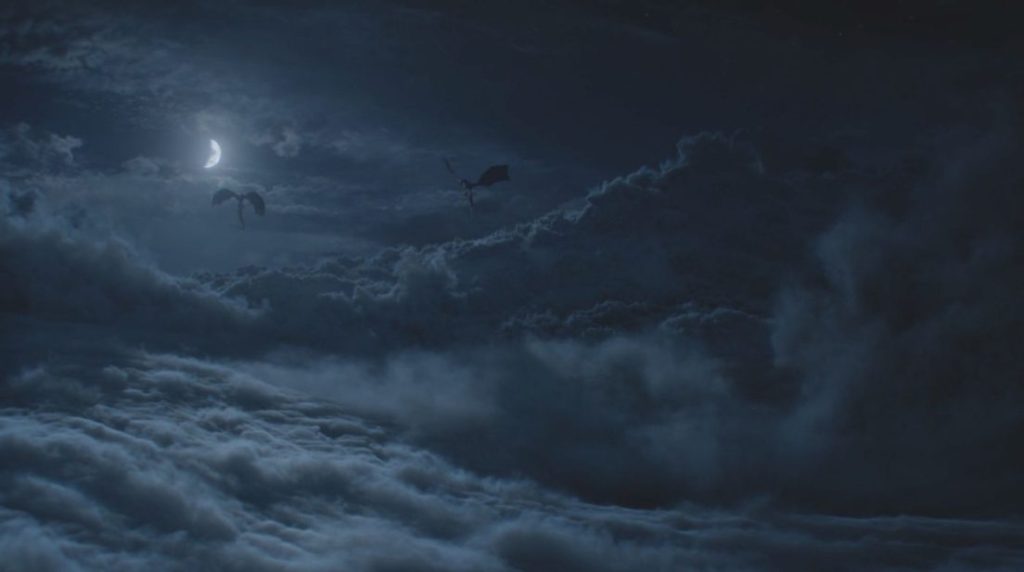
It’s easy to point to the rise of streaming services as the major culprit behind this blurring of the line, and while they’re an important part of this story, it’s worth noting that Netflix didn’t begin producing original films until Beasts of No Nation (directed by Cary Fukanaga) in October of 2015. To find the real start of this tectonic shift in the media landscape, the story begins with the so-called death of the mid-budget movie.
Much has already been written about this topic, most succinctly by Jason Bailey writing in Flavorwire in 2014, but to summarize: since the turn of the century, studio priorities have shifted to making fewer movies overall and loading the ones they do make with bigger and bigger budgets, to the point that most movies released by major studios are either $100+ million would-be blockbuster franchise tentpoles or small-budget indies hoping to strike gold. This leaves the mid-budget adult-oriented movies out in the cold. Unless you’re specifically trying to win Academy Awards (as studios only seem to finance mid-budget movies with adult sensibilities if they see little gold statues on the horizon), you better figure out how to tell your story for under $5 million.
This is troubling for a number of reasons, but one of the biggest causes for concern is that talented (and proven) filmmakers are being dissuaded from making movies because they just can’t find the financing. In a 2017 interview with Vulture’s Kevin Lincoln, writer-director James Gray (We Own the Night, Lost City of Z, and the upcoming Ad Astra) had this absolute doozy of a quote:
“The middle is gone. So now you have franchises, and you have, ‘I made a movie on my iPhone.’ This is the economic system in a nutshell, right? Five directors make Marvel, and then there’s the rest of us who are trying to scrounge around to find the money to make films. And it becomes a self-fulfilling prophecy: If the audience only gets to see Marvel, then they only want Marvel, and then if they only want Marvel, only Marvel is made. I don’t even have a problem with Marvel. The problem is not the specifics of each movie, the problem is it’s the only movie you can see now in a multiplex, and when it’s the only game in town, you’re looking at the beginning of the death throes of an art form.”
Oof. And thus the well of the mid-budget movie – which gave us Coppola and Scorsese in the 70s and David Lynch and John Waters in the 80s – dried up. David Lynch hasn’t made a feature film in thirteen years (instead spending years writing and producing a ground-breaking third season of his ground-breaking television show). Steven Soderbergh retired from filmmaking in 2011, made the jump to television by directing two seasons of The Knick for Cinemax, then returned to movies with Logan Lucky in 2017, a mid-budget box office failure that he has followed up with two movies shot on iPhones (proving James Gray’s point two-fold).
Another side effect of the death of the mid-budget movie, beyond the migration of interesting storytellers, has been the migration of interesting stories. While it may intuitively seem like the sky is the limit when your movie has a budget on the scale of hundreds of millions of dollars, that kind of movie is relatively limited in the kind of story it can tell, as studios will only want to take a big financial swing on something they’re confident will connect with as wide an audience as possible. That’s why huge-budget movies are typically more broad and less apt to take risks story-wise- the investment is too large to not play it safe. Conversely, while micro budget movies made for $5 million or less usually have more freedom to be less conventional or try something new, the shoestring budget limits the story possibilities in other ways, as filmmakers can’t afford certain special effects, can’t afford to shoot in certain locations, or can’t afford certain stars and talent.
Television shows have stepped in to fill that void in complex characters and adult-oriented storylines. As shows expanded beyond the four major networks and began to deviate from the 22- or 47-minute episodes and 24-episode seasons that defined the first half-century of their existence, the stories began to change as well. As streaming platforms began producing shows of their own, episodes no longer had to conform to a specific time allotment and no longer had to end in a way specifically designed to draw viewers back a week later (in some cases, they’re designed to draw the viewer into immediately watching the next episode, but that’s far from a requirement- the first episode of Netflix’s first show ends with the main character sitting down to a basket of ribs and the second episode begins with him finishing the ribs). The limitation of story possibilities in film coincided with the expansion of story possibilities in TV.
And as more interesting stories and more interesting characters began disappearing from movies and popping up on TV, stars noticed. All actors, even famous ones, crave interesting parts, and they’ll go where those parts are. It used to be that TV acting was seen as a step down from film acting, but with the rise of prestige television, that was no longer a problem. And with anthological series and miniseries (like Chernobyl) becoming more and more popular, the time commitments that used to scare actors away is no longer a problem. Mary Elizabeth Winstead said as much in an interview with NPR about her role in Season 3 of Fargo on FX.
“For me, it was really the idea of committing to something for years and years – that you could potentially not love – was very, very scary to me. I was sort of like, I don’t understand why anybody would do that! What if you get into it and then a year later you decide you don’t like it anymore? But the past few years, as the majority of the good material that I’ve seen has been on television, it’s become really exciting… So I don’t really concern myself with the platform anymore, because it doesn’t really seem to matter.“
Here’s an incomplete list of actors and actresses nominated for Best Actor/Actress in a Limited Series or TV Movie at the 69th Emmy’s in 2017: Nicole Kidman, Robert DeNiro, Benedict Cumberbatch, Reese Witherspoon, Ewan McGregor, Susan Sarandon, Geoffrey Rush, Jessica Lange, and John Turturro. Case in point. Actors used to yearn to make the television-to-movies jump, hoping to make the transition and never looked back, and now they’re flocking to TV.
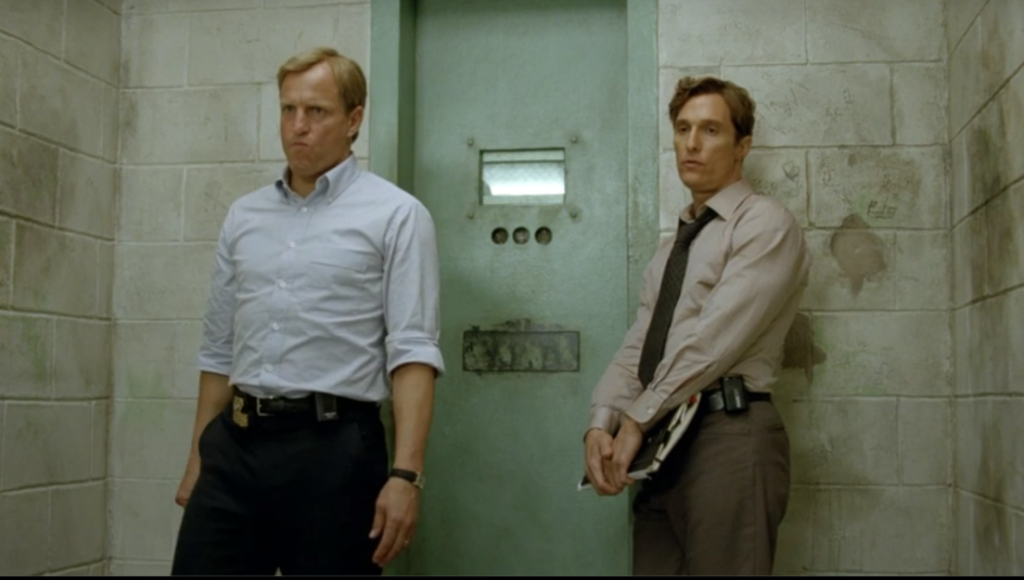
When Matthew McConaughey and Woody Harrelson teamed up for the first season of True Detective, it was nearly indecipherable from a movie, both for the A-list talent in front of the camera (McConaughey won his Oscar for Best Actor the same night the penultimate episode of True Detective aired) and in how it was shot (the uber-cinematic six-minute long take in episode four was not something you would’ve seen in a TV show ten years ago). To boot, it was conceived as only eight hours from the start; it told a complete story with a beginning, middle, and end, just as a movie would but in four times the runtime.
Plenty of showrunners and television folk promote their show as a “10-hour movie” or however long their show is, and it’s almost always a disingenuous attempt to lend their show the gravitas of a movie, but True Detective had a legitimately intriguing argument to declare itself an 8-hour movie. To add to the aforementioned list of distinctions between TV and movies, from a production standpoint, movies go through writing, production, and post-production before the audience sees the finished product. TV shows are (were?) typically written, shot, and edited on a rolling basis throughout a given season, e.g. Episode 16 is being written while Episode 13 is in production while Episode 11 is in the edit while Episode 10 is airing for everyone to see. True Detective, on the other hand, was shot in one fell swoop. Editing of later episodes may have still been happening as the first episodes aired, but production had wrapped before any audience saw a second of the show.
Furthermore, instead of being written by a team of writers and directed by a swinging door of directors-for-hire, as is the case for nearly every other TV show, True Detective was written in its entirety by Nic Pizzolatto and directed by Cary Fukanaga (whose following project would break Netflix into the feature film game with Beasts of No Nation). McConaughey said repeatedly in interviews that he treated True Detective as a 450-page movie script, and for all intents and purposes – from how it was written and produced, how it was shot, and who it starred – it was.
It might be worth mentioning the eight-episode structure of True Detective, as the 8-episode season has become more and more common in recent years (22 used to be the norm for network TV and 10 or 13 was more common on premium cable). The three-act structure for movies is a fairly nebulous thing that’s more difficult to pin down into a formula than many screenwriting teachers want you to believe, but it’s generally agreed upon that the second act is much longer than the first and third, often twice as long. To make the long second act more manageable, many screenwriters divide it in half with a midpoint climax of sorts. So you can really look at the structure as either three acts of differing lengths or four acts of roughly the same length. All to say, while the three-(or four-)act structure isn’t something that can be applied to every movie, and isn’t a perfect formula for writing a story, it’s often a useful tool when analyzing a story after the fact. And it’s crystal clear how much eight-episode seasons of shows like True Detective, Stranger Things, and even Barry follow the beats of a four-act feature screenplay in regard to where certain plot points occur within their eight-episode framework, with every two episodes representing an “act”.
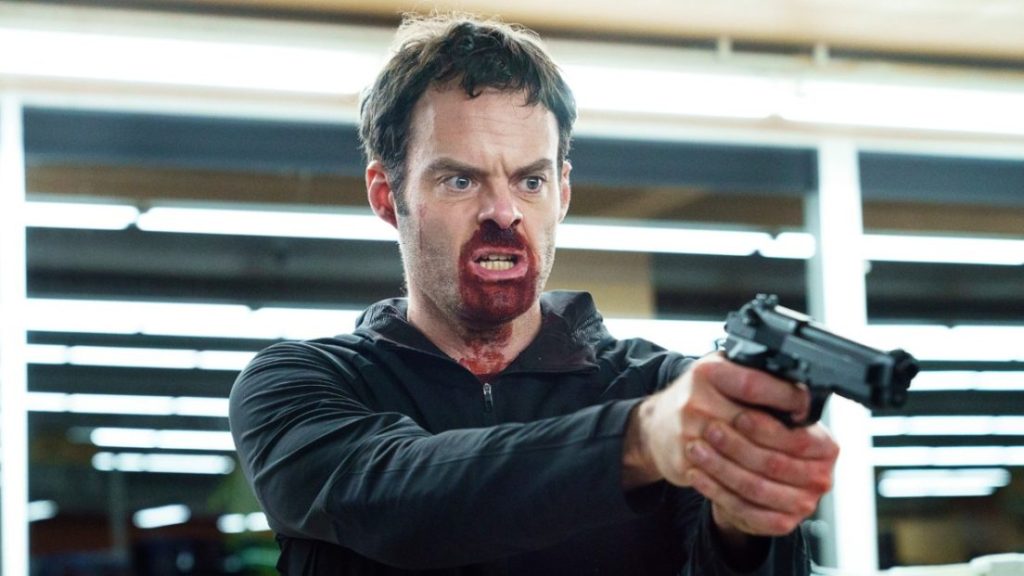
The inciting incident of a movie – the event that kickstarts the story into action – usually occurs in the middle of the first act, and the “inciting incident” of the dominate season-long story arc in these eight-episode seasons so often occurs at the end of the first episode, i.e. in the middle of the first “act” (Cohle reveals the Yellow King is active again in 2012; the gang finds Eleven; Barry kills the Chechkins). The aforementioned midpoint climax, if it exists, breaks the second act of a movie into two halves, and lo and behold, in each of these shows there’s a major climactic moment that changes the course of the story at the end of the fourth episode (the six-minute oner of the robbery gone wrong; Hopper finds out Will’s body is a fake and he might still be alive; Taylor learns about Barry’s gig as a hitman and wants in).
This is all just a way to say that these shows follow the structure of a feature film very closely, possibly more than you would think at first glance, such that the “eight-hour movie” (or “four-hour movie”, in the case of Barry) moniker holds a bit of weight. Even though they’re not eight episodes, you can similarly extract a feature film structure out of contained, close-ended miniseries like Big Little Lies and Chernobyl, both of which, like True Detective, were written in their entirety by one screenwriter and directed in their entirety by one director (Stranger Things and Barry were written by a more conventional TV writer’s room and had a rotating roster of directors).
Just like how Matthew McConaughey treated True Detective as simply a long feature screenplay, Big Little Lies director Jean-Marc Valeé had similar thoughts on his seven-episode miniseries:
“You know, I was asked: ‘What was your transition to television?’ I said, “What are you talking about? There’s no transition to television. It’s the same thing.” I approach this like a long feature film-just another project, but it’s not for the big screen, it’s for HBO. But I do it as if it was for the big screen. I still have this desire to give a good show for the big screen.”
Granted, although these close-ended miniseries are directed like a movie, are written and structured like a movie, and feature movie stars, they are still more episodic in nature than a seven- or eight-hour movie would be. They are still (for the time being) intended to be watched in discrete one-hour chunks and not in one fell swoop, even if streaming services are beginning to push this boundary. While a season of Fleabag on Amazon (also written by one person and directed by one person) has the same runtime as Avengers: Endgame, and plenty of people watched all six episodes in one three-hour chunk, those three hours are still written to be more episodic than a movie; it’s not like Fleabag is a three-hour movie that they just decided to present in six half-hour chunks.
Ope, but wouldn’t you know it, that’s a thing now too: in April, Netflix presented an “extended version” of Quentin Tarantino’s 2015 film The Hateful Eight as a miniseries of four 50-minute episodes. As it turns out, this miniseries is nothing more than a cut-up version the original movie with a couple of extra scenes (that were included in the 187-minute “roadshow” edition of the movie that toured 100 cities ahead of the movie’s official release) and a few more minutes of credits. Tarantino already writes most of his movies in “Chapters”; Netflix just took the logistical step of presenting those chapters in a more discrete format that has become the chosen mode of media consumption for more and more viewers. I can’t get my wife to sit down for a movie that runs a minute longer than two hours, but she’ll gladly watch three or four hours a TV show in one sitting. Maybe there’s something to Netflix’s Hateful Eight strategy…

It’s all a big cause-and-effect loop with the different elements feeding into each other. Streaming and other home-viewing options changed theater attendance, which changed studio priorities, which changed the stories that movies were able to tell, which changed the stories TV shows were telling. This was further changed by streaming and evolving distribution options (read this Infinity Dish blog to know more), and now movies are telling years-long serialized franchise stories and TV is telling close-ended narratives neatly wrapped up in a matter of hours. The term “TV movie” used to be a derisive term, as the occasional TV movie produced by a network was almost always seen as lesser than its theatrical counterparts, but now a movie that took home the Best Director Oscar was overwhelmingly seen by people at home on their TV screens (and Netflix is now gunning for Best Picture next year with a star-studded $200 million Martin Scorsese gangster movie, brazenly advertised during this past year’s Oscar telecast). Movies that competed for Oscars are going on to win Emmys six months later.
Are we headed for an era where the only difference between what makes something a movie or a TV show is runtime? With shows like Chernobyl looking nearly indistinguishable from a five-hour movie, it’s possible.
Just don’t be surprised when the third season of Big Little Lies wins Best Picture at the 2022 Oscars.
